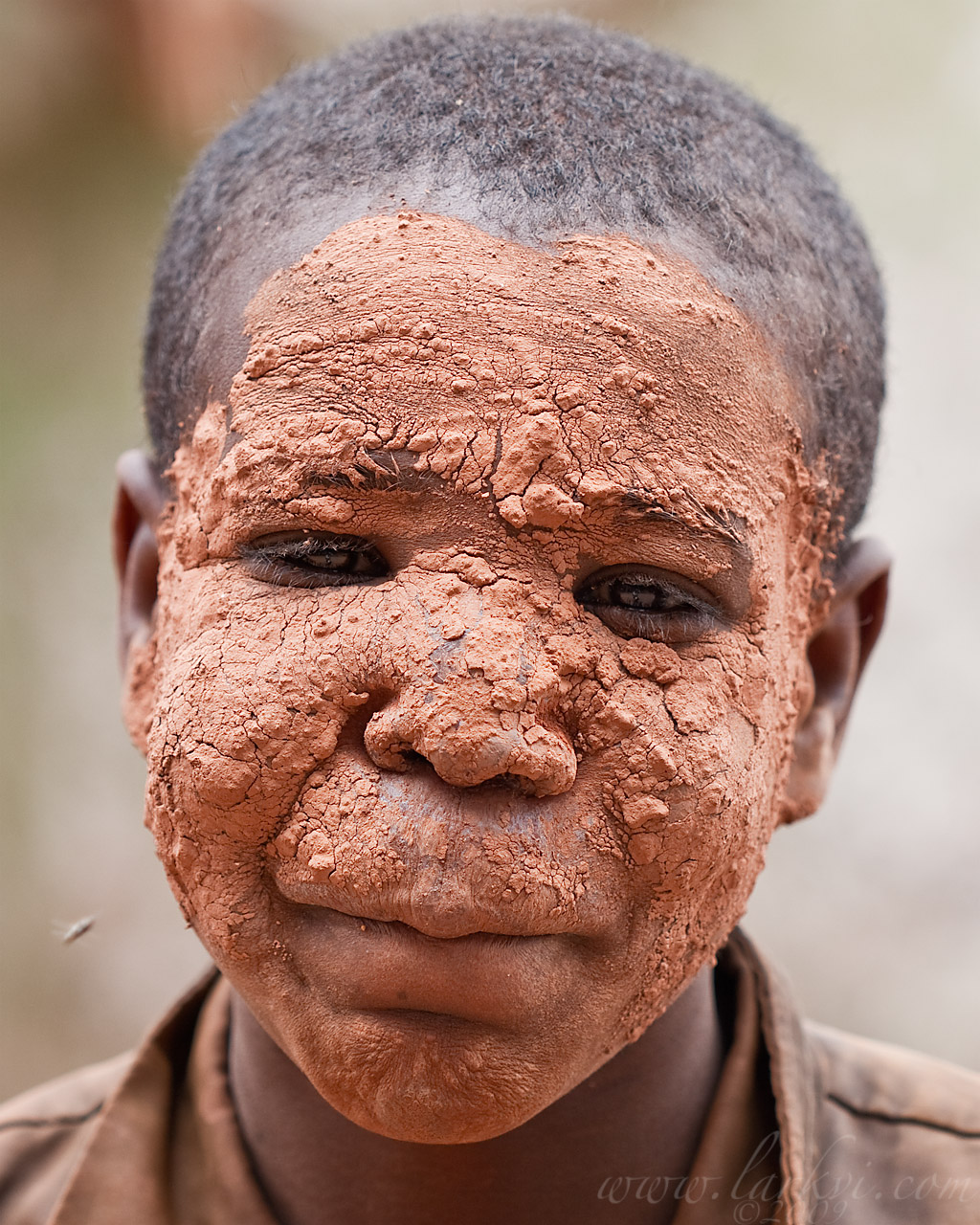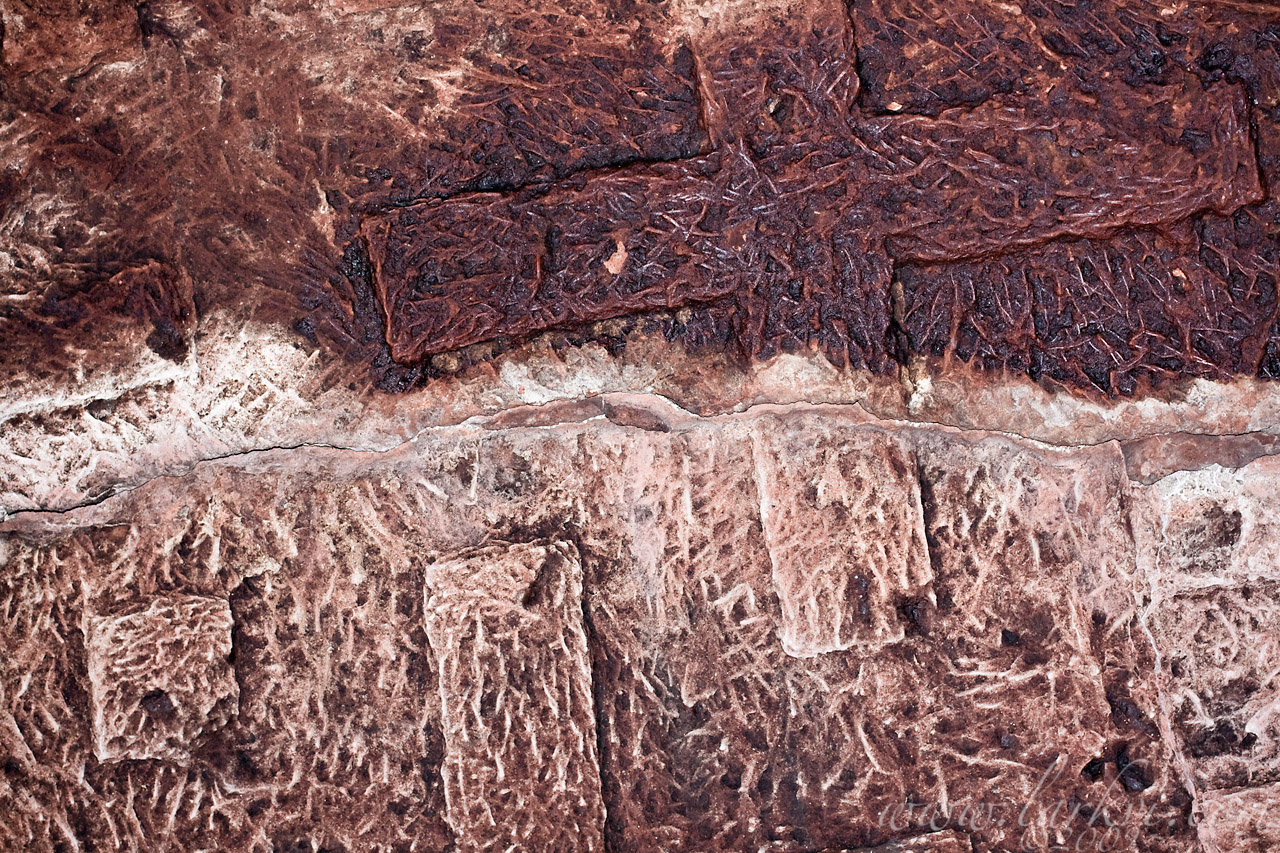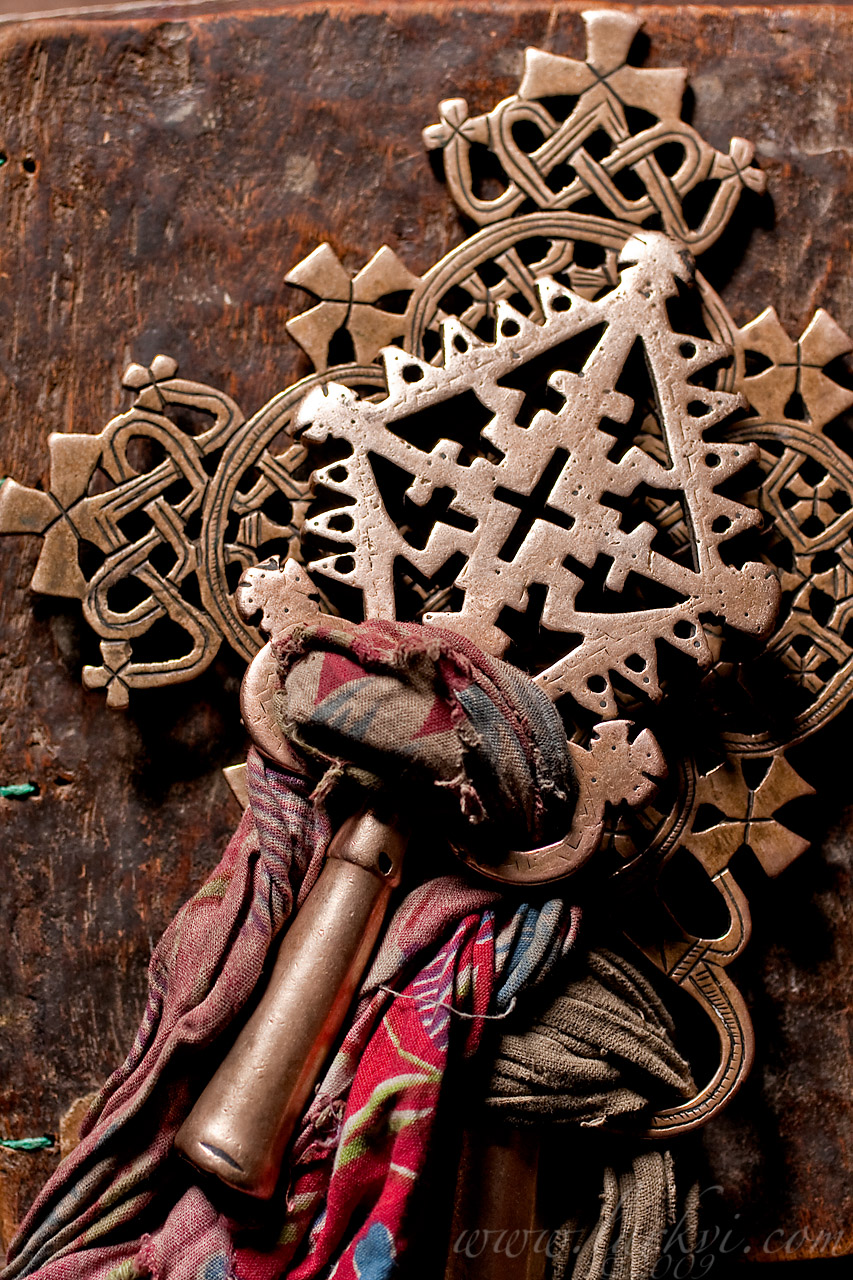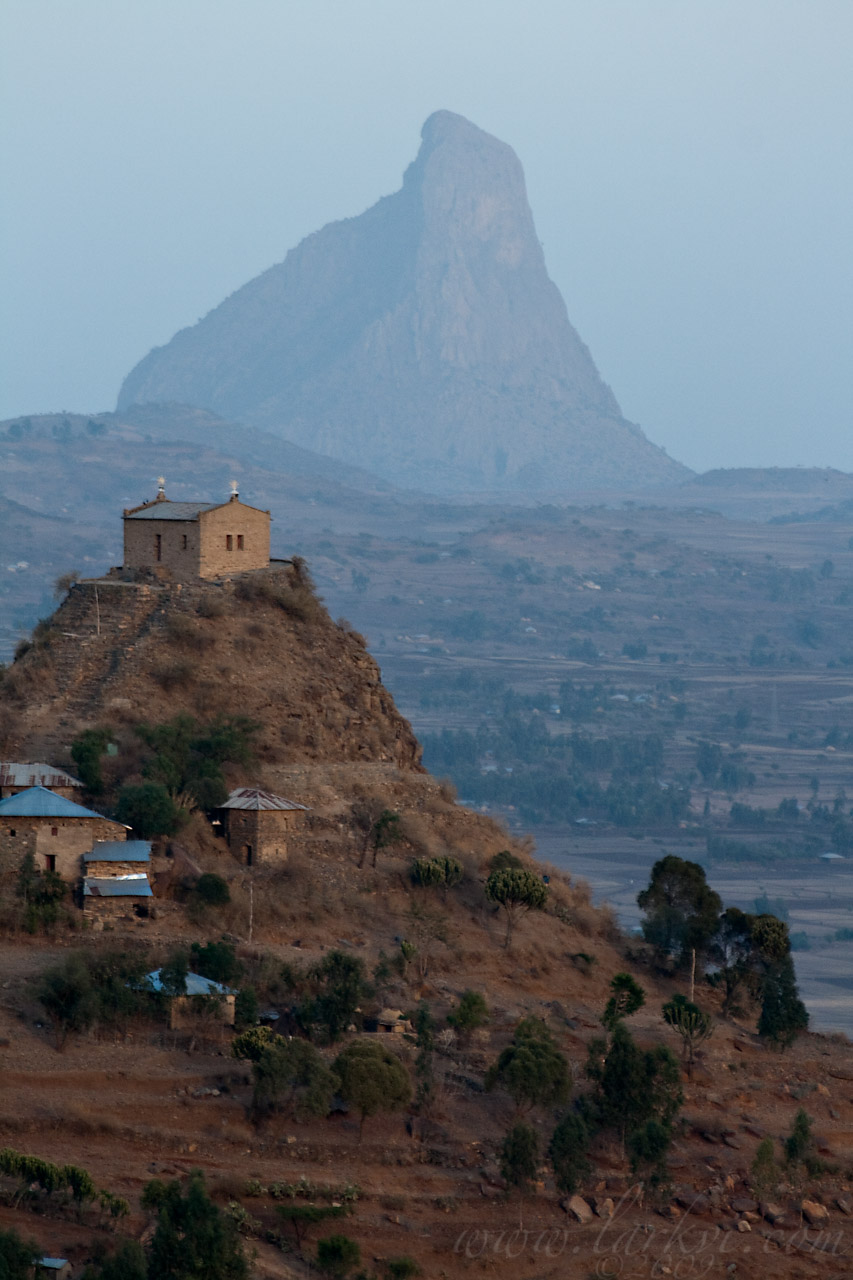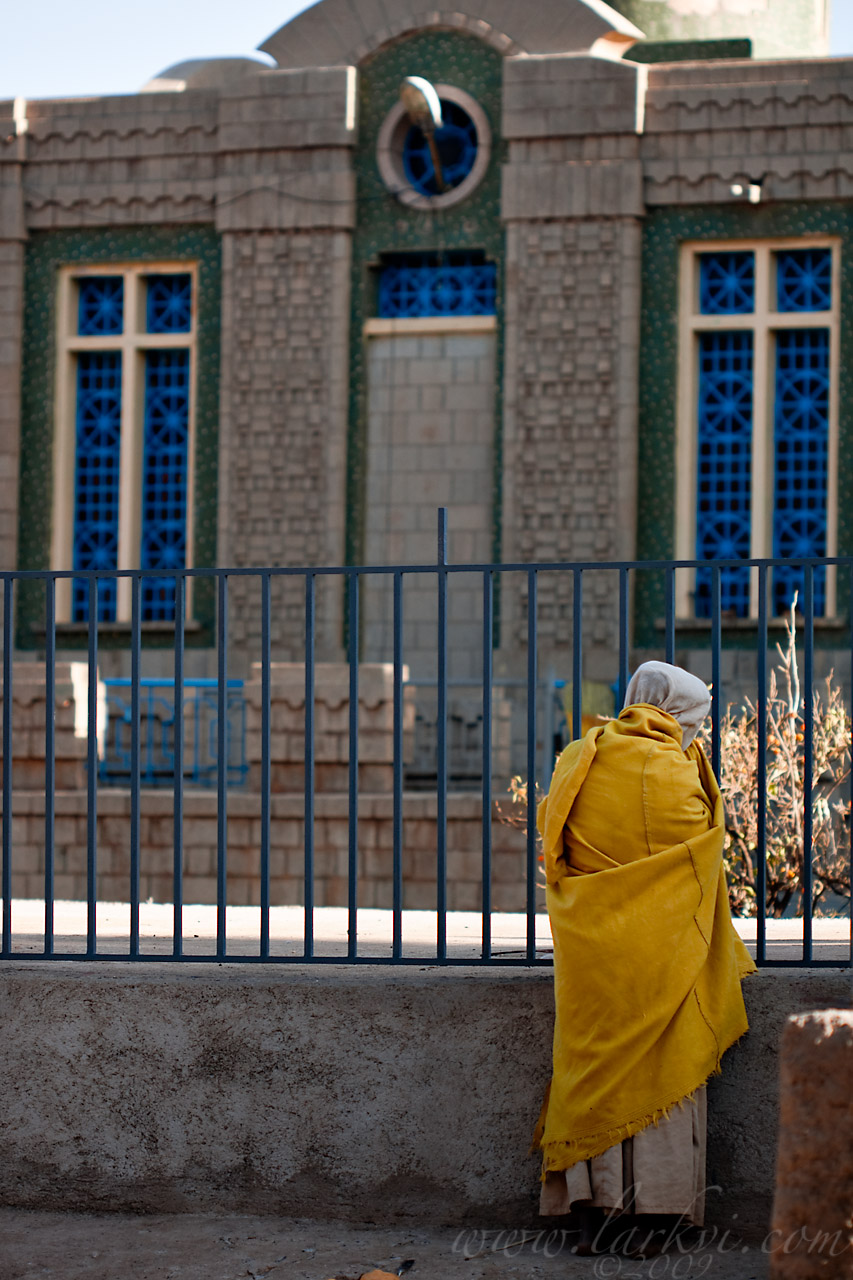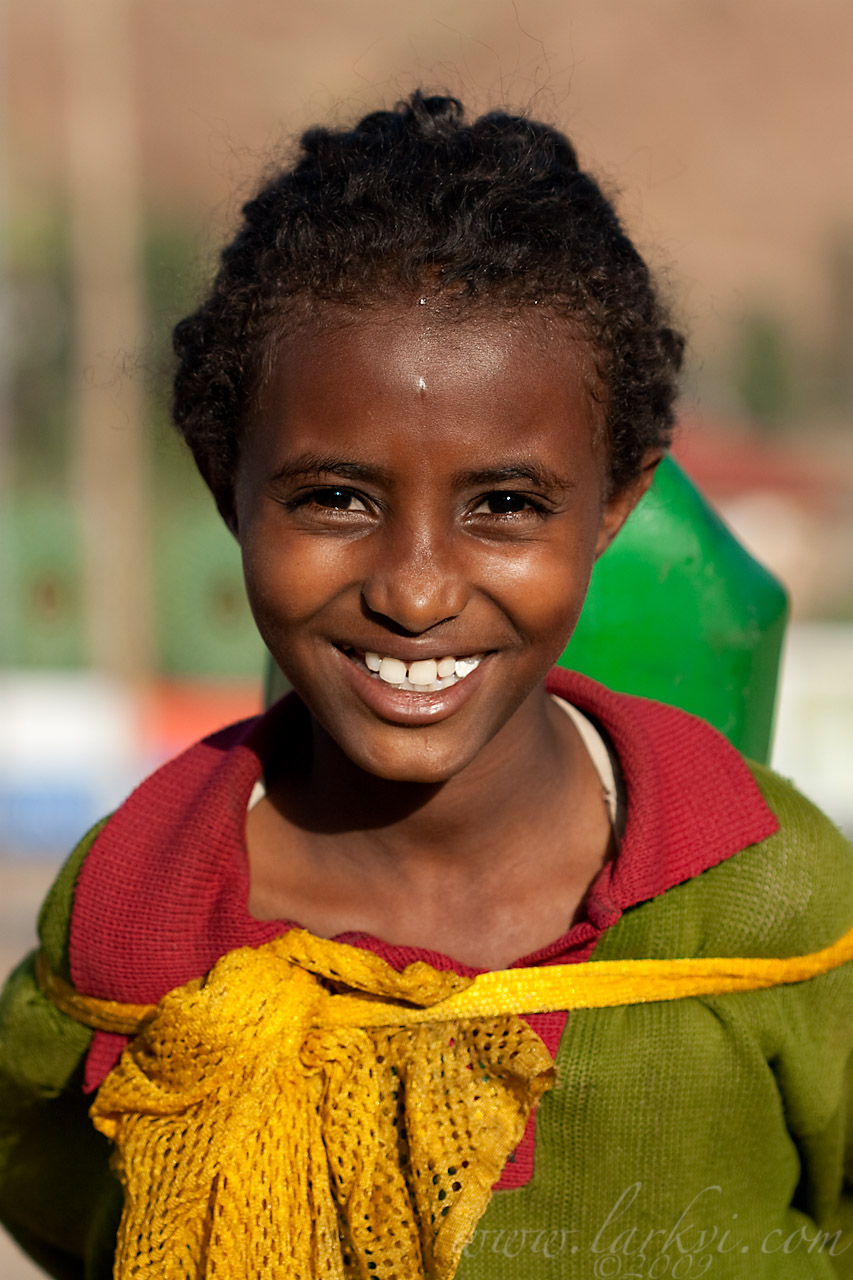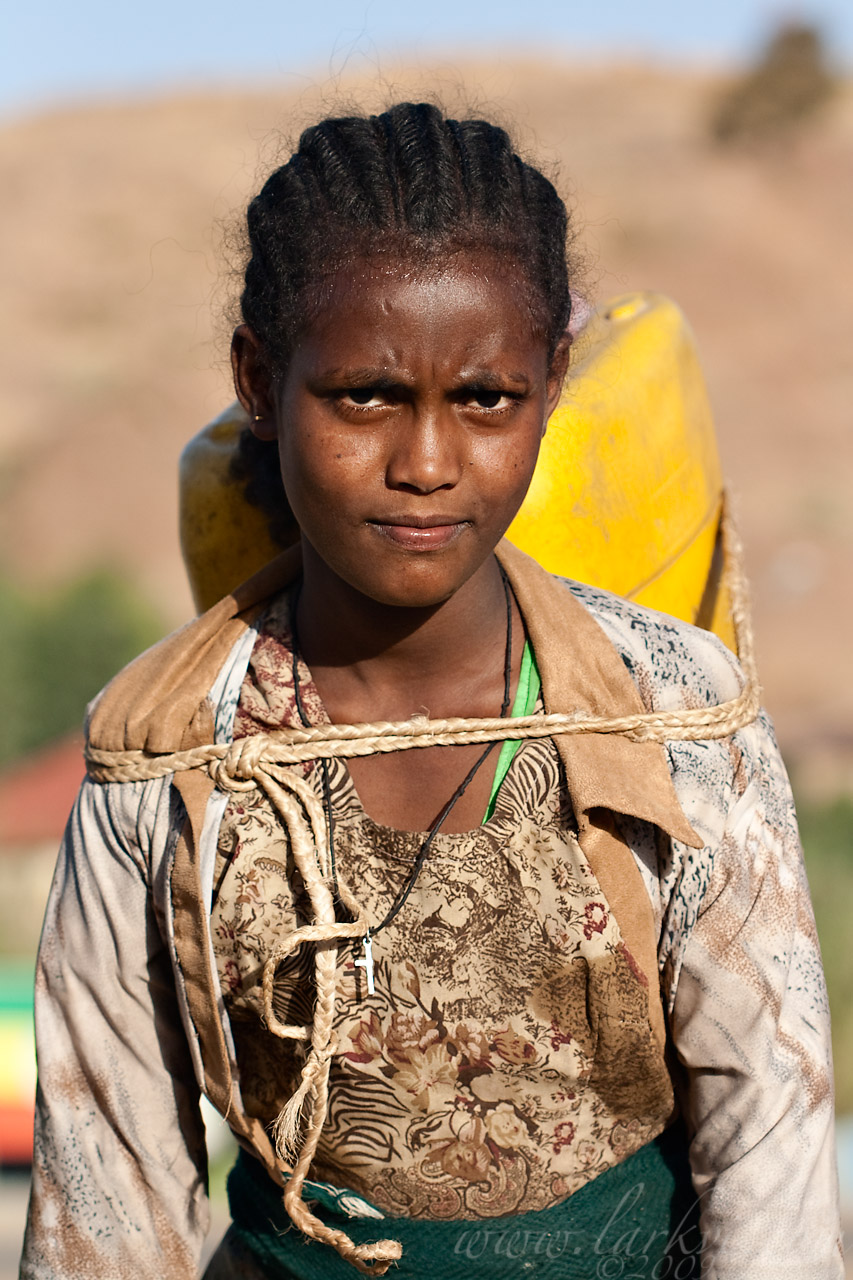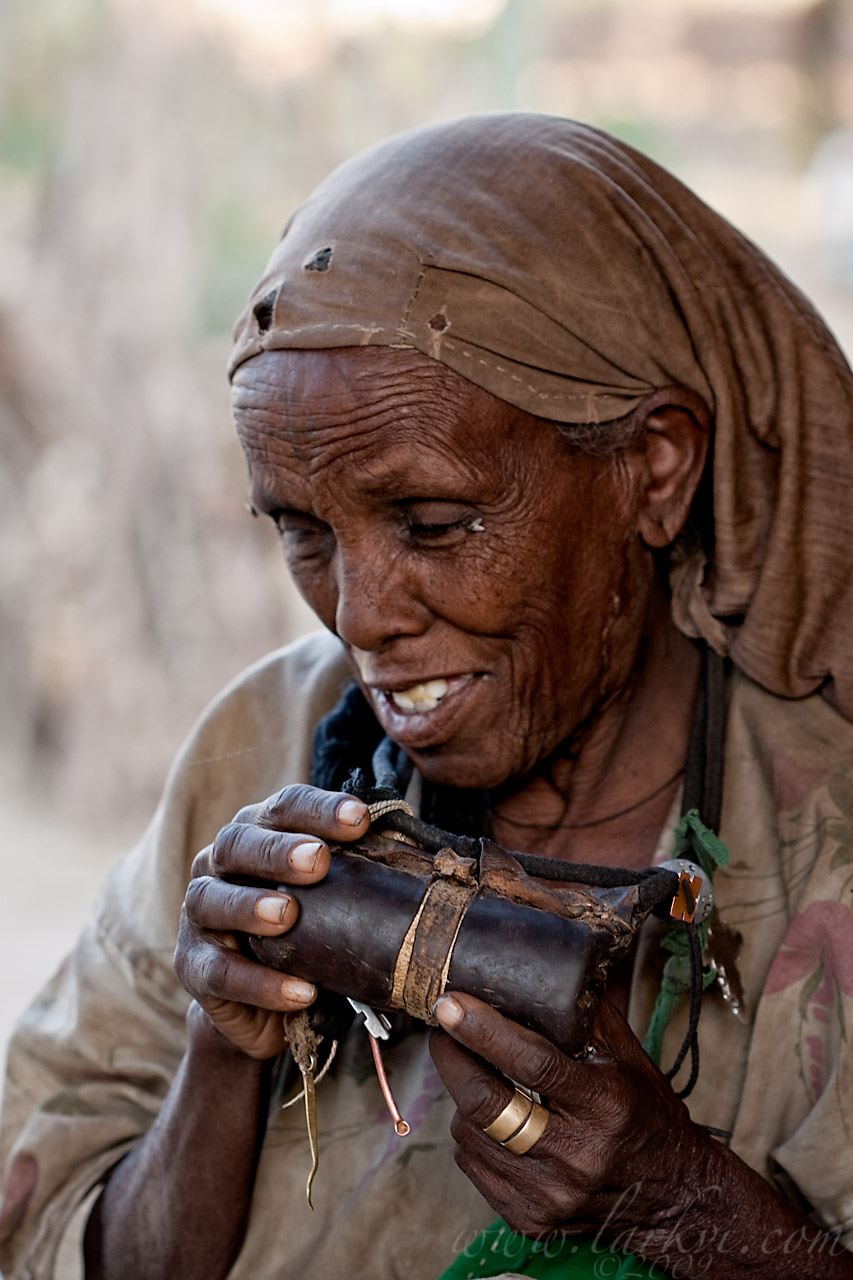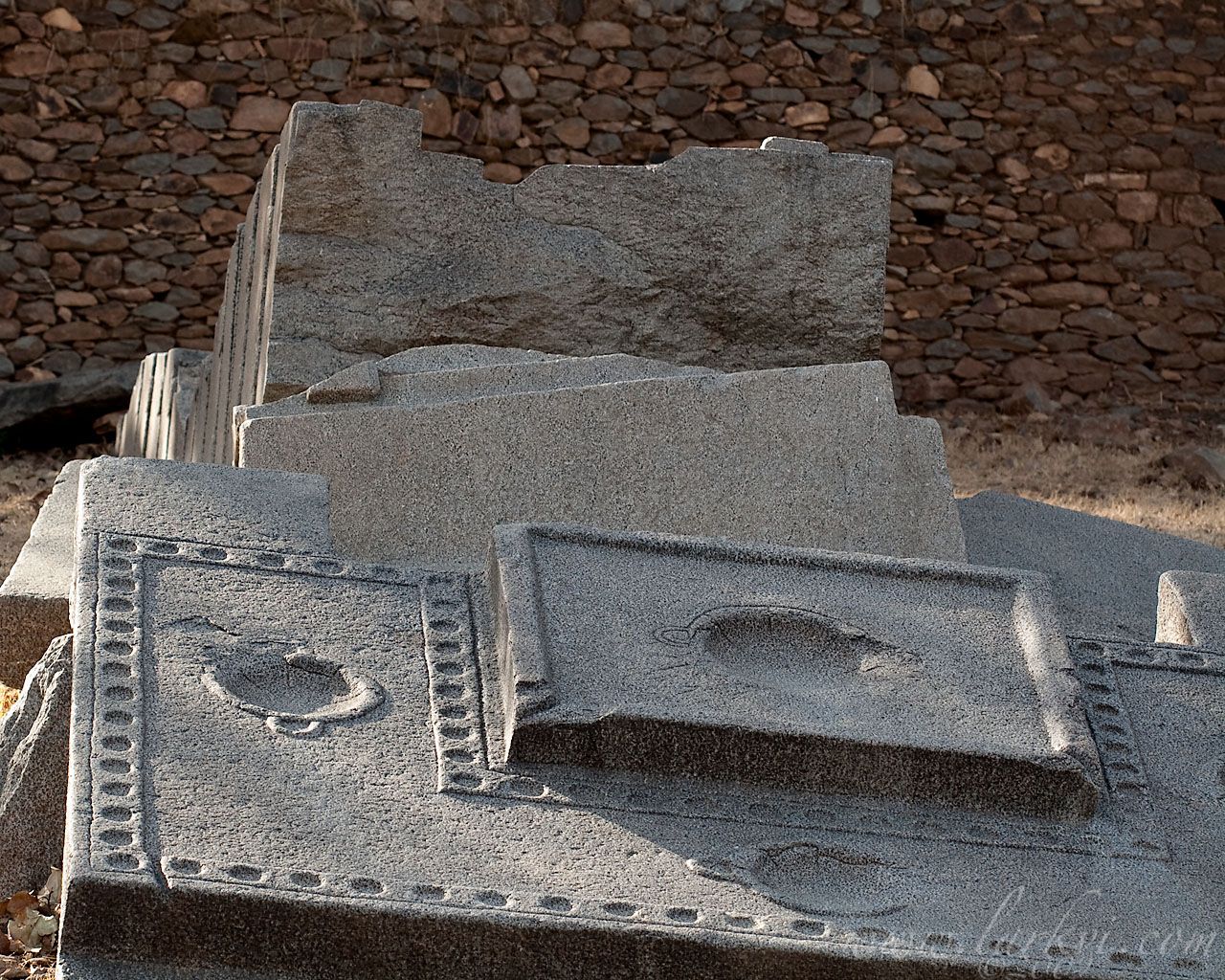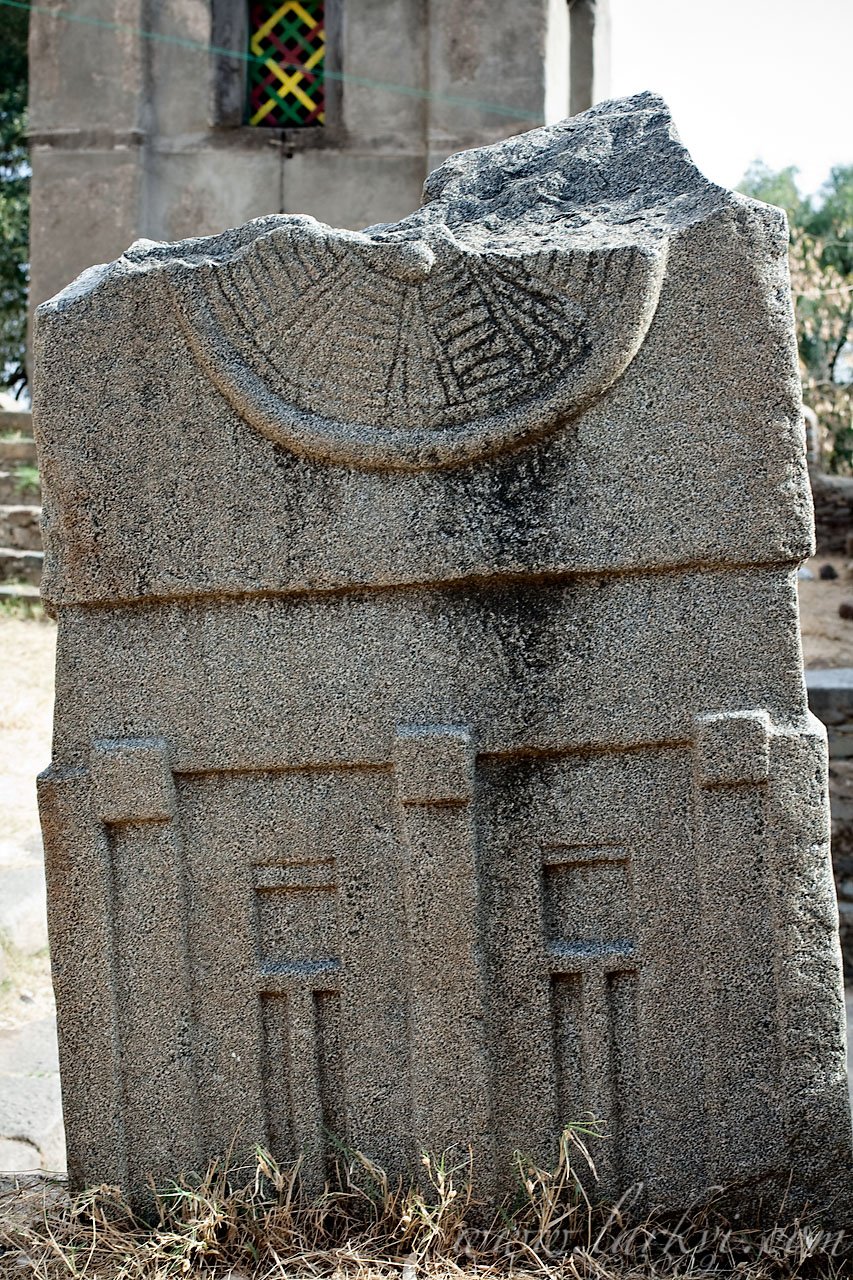This boy had come to Bilbala Gyorgis (rock-hewn) Church, above the town of Bilbala, outside of Lalibela, to take the cure of its holy mud. Clay dirt from inside the church is mixed with holy water, then plastered onto the afflicted part; in this case, the boy presumably has some form of skin disorder. Bilbala Gyorgis, in addition to holy water and holy mud, offers pilgrims holy honey, from bees that have built combs in the former windows of the church.
Roof crosses, Bilbala Gyorgis Church, Lasta, Ethiopia, June 2009
Crosses, Bilbala Q’iros Chuch, Lasta, Ethiopia, June 2009
Abba Pentalewon Monastery, Axum, Tigray, Ethiopia, May 2009
Praying at the Ark Chapel, Axum, Tigray, Ethiopia, May 2009
A nun prays facing the chapel/treasury where Ethiopian tradition claims the Ark of the Covenant is stored.
According to the Kebra Negast, the Ethiopian national legend, the Queen of Sheba had a child of her rape by Solomon, named Menelik. When the child was grown, he asked of his father, so the queen told Menelik of Solomon (whom he apparently resembled perfectly) and gave him a ring to identify him. When Menelik traveled to Israel and showed the ring to his father, he was accepted with much rejoicing; Solomon appointed the first-born sons of all his chief advisors to be Menelik’s advisors, and to serve at the court in Ethiopia [sic]. As the eldest sons were due to inherit their fathers’ positions, much more desirable than foreign exile, they were understandably annoyed, and conspired with the son of the chief priest to take the Ark with them, that they might not be robbed of its proximity. When the time to leave came, they took the ark out at night, and fled to Ethiopia; because the Ark grants a supernatural bonus to overland movement, the pursuing army was unable to catch them.
When he returned to Ethiopia, Menelik established a housing for the Ark based upon that described in the bible, and it has remained in Ethiopia ever since, moving to a variety of places over time. One monk is assigned sole care of the ark and the upper-floor of the treasury that houses it for the remainder of his life, choosing another just before he dies. Lest you think there is only one guardian to get past, the monk’s compound is itself guarded by men with automatic rifles, and those who get too close to the Ark reputedly burst into flames, in any event.
Though the myth is generally compatible with the historic record, this has more to do with it being based in the same sources that we would use to evaluate it as anything else. There are loads of problems, mainly that the Queen of Sheba (Sabea) would not have lived in Ethiopia, but in Sabea–South Arabia. She is not a historic figure, but possibly the conflation of later queens–there were no female monarchs of Sabea during the time of Solomon, and the story is entirely mythical. It’s also unclear whether, as is claimed, Ethiopia was ever Jewish at all–I personally doubt it, and scholarship cannot agree on this point. If there is a grain of truth at the heart of the Solomon and Sheba myth, the parts that the medieval legend recounted in the Kebra Negast builds upon are wholly fictional. Given Ethiopia’s many wars and its great pride in ownership of the Ark, I also find it very odd that they have never carried the Ark, which, in the Old Testament, is a military super-weapon, into battle, nor paraded it around, like they do with the tabot. I have definitely experienced a large number of claims by priests and the Church here that would be easily falsifiable and have no religious reason for being hidden, but the secrecy surrounding them strongly suggests that they were made up–I would be loved to be provved wrong on this, if anyone ccan arrange for me to navigate the secret tunnel from Mt. Asheton to Na’abtela, or from Axum to Arabia. . .
Whether false or true (and churchmen here will not acknowledge in any way that it might not be true), it is a core part of Ethiopian religious belief, which has structured the way churches are consecrated around the tabot, ark-replicas that ensure the holiness of each church (Churches are not holy in Ethiopia, tabot are).
Water-bearers, Axum, Tigray, Ethiopia, April 2009
These girls were carrying water from the “Queen of Sheba’s Bath,” a reservoir that has been in use since ancient times, to their homes. Before the advent of cheap plastic goods, local pottery would be used, and in rural areas, one can sometimes still see women and children with large ceramic jugs strapped to their backs in the same fashion as these plastic ones.
The traditional jug is similar to the one I photographed here, in Southern Ethiopia:
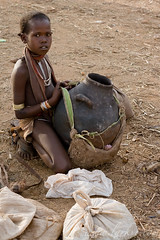
Woman and Scroll, Axum, Tigray, Ethiopia, May 2009
An old woman shows her Kitab Ma’ari–a traditional magic scroll commissioned as a form of healing and worn in a scroll-case around her neck. The prayers on the scroll will be to protect from harmful magic, such as the evil eye or the magic of däbtäras (magicians) as well as to enlist the aid of angels or other powerful magical creatures with the aid of astrological correspondences (determined through a process known as gedfät). While the length of the scroll is regulated by her height, the great width of this scroll (and her obvious illness) suggests that there are extra magical prayers and talismanic images (Kitab or Tälsam), rather than the 3 or 1 that are normal.
I almost did not take this photo–I was just giving alms to the ill beggars that sit at this particular entrance to the St. Mary of Zion Church compound, on my way to the old church, when I noticed that this woman was wearing an extremely-large example of one of the texts that I was studying. She was gracious enough to let me take a photo to illustrate the way that these texts are worn.
Magic is regulated in Ethiopia as a form of medicine, and unlicensed or ‘black’ magic is punishable with prison. Most of the licensed practitioners are members of the Church, who are thought to have sufficient moral and religious training to use the magic effectively and appropriately.
If you are interested in seeing some images from magic scrolls, see Mercier, Jaques. Ethiopian Magic Scrolls.
Double Stela, Beta Gyorgis Quarry, Axum, Tigray, Ethiopia, May 2009
The so-called “double stele,” which sources have identified as an incomplete two-topped stela. I somewhat wonder if it is not just the incomplete-quarrying that has led to this identification, but it is interesting to see two stelae quarried immediately adjacent to each other, in any case.
The Beta Gyorgis “House of (St.) George” Quarry is on the hill above Axum, but was significantly less-important than the Gobedra quarry 5km outside of town. The stela(e) show how the quarrying worked–grooves were cut out of the rock before being freed. Stelae were apparently unworked when they were translated into Axum, and carved in place–a sensible way to avoid wasting effort on something that breaks in transit.
I don’t claim any art to this photo–it was taken in middle off a very sunny day, and it shows!
Stela 4, Axum, Tigray, Ethiopia, May 2009
Stela 4 has the best-preserved altar of any of the stelae, its altar depressions being well-preserved, as opposed to those of stela 3, which were used by local women as mortars. The head-piece, separated from the rest of the stela during its fall, now rests in the compound of the old St. Mary of Zion Church.
It has been suggested that the round representation on the head is a traditional ethiopian bread, but I am somewhat skeptical as to the importance and symbolism of bread in such a case, given what we know of Sabean religious customs, and wonder if it couldn’t be the sun or a traditional shield instead.
Leaving on Research
I am heading out in the morning for Lalibela, Gonder, and Andabet, working on research. I will be posting intermittently or not at all for the next few weeks, as I will likely only have internet access for a small portion of the trip.

